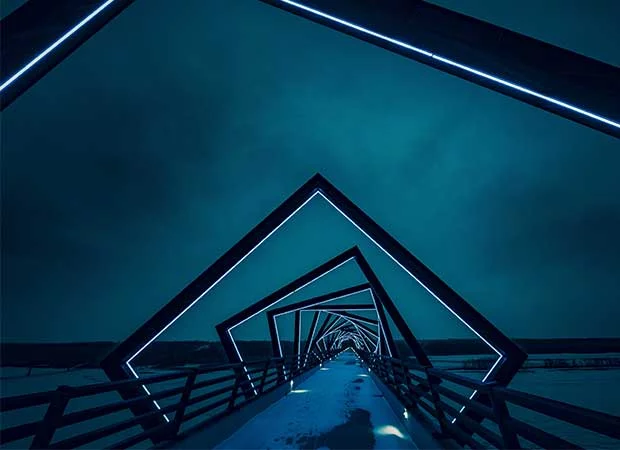Exploring the Intersection of Illusion, Innovation, and Design
Architecture has always been more than just building structures—it’s a form of storytelling, an art of manipulating space, light, and material to evoke emotion, function, and imagination. But what happens when architecture begins to trick the mind? Welcome to the fascinating world of mind-bending architecture, where perception meets innovation and reality often blurs into illusion.
This architectural genre is gaining momentum in cities across the globe—from the kaleidoscopic facades in Tokyo to the gravity-defying museums in Dubai and the deceptive depths of underground spaces in New York. These structures not only showcase creativity but also challenge how we perceive the world around us.
In this article, we’ll explore how architecture tricks your mind, the psychology behind visual deception, the global trend of illusion-based design, and what it means for the future of urban environments.
What Is “Mind-Tricking Architecture”?
Mind-tricking architecture refers to designs that intentionally manipulate human perception. These structures use optical illusions, asymmetry, forced perspective, unexpected angles, and strategic lighting to create an experience that challenges our spatial awareness.
This type of architecture is not just visually captivating—it creates a dialogue between the built environment and the human brain. The goal? To surprise, engage, and sometimes disorient, in a way that makes the experience unforgettable.
How the Brain Interprets Space and Illusion
Our brain is wired to recognize patterns. It fills in gaps, assumes consistency, and interprets 3D spaces based on visual cues. When architecture breaks those patterns, it forces the brain into a momentary glitch—a pause to reassess.
Key Psychological Elements:
- Pareidolia: Seeing patterns, like faces or figures, in objects or buildings.
- Gestalt Principles: How humans organize visual elements into groups or unified wholes.
- Forced Perspective: Making objects appear larger, smaller, closer, or farther than they actually are.
- Ambiguity: When visual information leads to multiple interpretations.
By tapping into these cognitive biases, architects and designers can create experiences that feel magical, mysterious, and even meditative.
Global Examples of Mind-Bending Architecture
1. The Crooked House – Sopot, Poland
Known locally as Krzywy Domek, this whimsical building looks like it melted under a surrealist sun. Inspired by fairy tale illustrations, its warped walls and curved windows challenge your expectations from the first glance.
2. The Museum of Illusions – Dubai, UAE
This mind-bending space showcases how architectural and interior design can blend with optical art to play with perception. Tilted rooms, endless mirror mazes, and anti-gravity chambers make visitors question reality.
3. The Dancing House – Prague, Czech Republic
Also known as “Fred and Ginger,” this building appears to sway like two dancers mid-twirl. Designed by Frank Gehry and Vlado Milunić, it breaks conventional form to create fluidity in rigid urban lines.
4. Casa Batlló – Barcelona, Spain
Antoni Gaudí’s masterpiece is famous for its organic, flowing forms, illusionary windows, and a roof that resembles a dragon’s back. It feels alive, evolving as you move through it.
5. Mirrorcube Tree Hotel – Harads, Sweden
A perfect blend of camouflage and design, this hotel room is suspended in the forest and covered in mirrors, making it virtually invisible. The trick? Reflecting nature so precisely, it disappears into the woods.
Geo-Friendly Designs with a Twist
Mind-tricking architecture isn’t just for aesthetics—it can serve sustainability and local adaptation goals too:
- Reflective surfaces in hot climates like Abu Dhabi help reduce heat absorption.
- Tilted rooftops in Scandinavia help manage snowfall while creating optical illusions from ground level.
- Earth-sheltered illusions in places like New Zealand merge buildings into hillsides, disappearing from view while reducing energy needs.
This blend of geo-awareness and design trickery makes such architecture environmentally responsible while keeping the “wow” factor.
SEO-Driven Architecture Trends
Today’s architects are becoming SEO- and AEO-aware. Why?
Because search-friendly architecture content fuels tourism, online engagement, and brand building. Structures that “go viral” drive real-world interest—think of how many people have traveled just to take photos with:
- The Upside-Down House in South Korea
- The Vessel in New York City
- The Infinity Mirrored Rooms by Yayoi Kusama
The Future of Illusion-Based Design
The coming decades will likely see even more interactive, immersive, and tech-driven architecture:
- AR-integrated buildings where illusions change based on mobile app filters.
- Smart lighting systems that reshape spaces based on time of day.
- Kinetic architecture with moving parts that shift form, creating ever-changing illusions.
- AI-assisted design tools that generate 3D illusions impossible with traditional methods.
Cities like Singapore, Tokyo, and San Francisco are already investing in this next phase of architectural evolution.
Why It Matters
At its core, architecture that tricks your mind invites you to pause, reflect, and feel. It’s not just about bricks and beams—it’s about how you interact with space. These structures remind us that reality is flexible, perception is powerful, and that creativity has no bounds.
In a world increasingly driven by screens and sameness, this kind of architecture stands out—boldly, bravely, and beautifully.
Conclusion: A World Worth Seeing Differently
If you’re a traveler, a designer, or simply someone who loves being amazed—seek out these architectural illusions. Let your senses be challenged and your imagination reignited.
Whether you’re walking the twisted halls of a distorted house in Poland, gazing up at a dancing building in Prague, or snapping a photo in front of an upside-down café in Seoul—mind-tricking architecture is a beautiful reminder that sometimes, things aren’t always what they seem… and that’s exactly the point.




